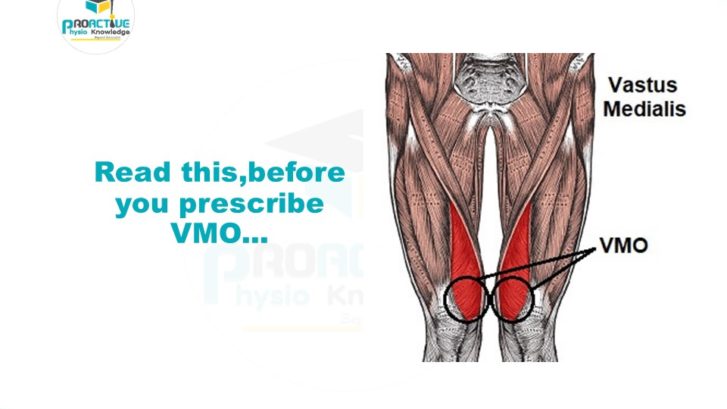Read this,before you prescribe VMO…

VMO and VL are synergists for knee but they act as an antagonists when it comes to patellar stabilization. They play a very crucial role in patellofemoral pain. Prevalence of PFPS in general population is 25% and 60% among athletes.
Theoretically it has been assumed that ratio of VMO: VL is 1:12 in ideal condition, but in patients with PFPS, it is found that it gets disturbed. VL is more dominant compare to VMO. Ratio of VMO: VL is around 0.54:11. This shows VL is more dominant than VMO owing to patellar maltracking.
To restore the disturbed VMO:VL ratio is very crucial in patello femoral pain syndrome. Ideally when Quadriceps is activated both VMO and VL gets simultaneously activated so our motto (restore patellar mal tracking) can be served only by choosing best Quadriceps exercise which activates more VMO than VL.
Suggestions have been put forward that closed kinetic chain exercises, such as squatting or lunging, utilize both multiple-joint proprioceptive reactions and muscular co-contraction. For this reason they are assumed to be a more functional intervention than open chain exercises (3).
SE Irish and colleagues4 did an EMG study with 22 subjects on activation of VMO and VL muscles in last 150 of extension (conventional way of VMO exercise) and also in squat position. They concluded that average muscle activation ratio VMO:VL during last 150 of extension in open chain kinetic exercise was 0.72:1 where as in close chain kinetic exercise (double leg squat with isometric hip adduction) it was 1.14:1.
So these results show that open chain exercise activates more VL than VMO which creates more mal tracking of patella which might worsen the PFPS patella femoral pain syndrome). So preferred exercise should be close chain double leg squat.
The study of Tang et al (3) showed that the greatest activation of VMO is actually achieved at 60 degrees of flexion in a weight bearing position.
Referances:
- Powers, CM. Patellar kinematics, Part I: The influence of vastus muscle activity in subjects with and without patellofemoral pain. Phys Ther 80: 956-964, 2000.
- Souza, DR and Gross, MT. Comparison of vastus medialis obliquus: vastus lateralis muscle integrated electromyographic ratios between healthy subjects and patients with patellofemoral pain. Phys Ther 71: 310-316; discussion 7-20, 1991.
- Tang, SF, Chen, CK, Hsu, R, Chou, SW, Hong, WH, and Lew, HL. Vastus medialis obliquus and vastus lateralis activity in open and closed kinetic chain exercises in patients with patellofemoral pain syndrome: an electromyographic study. Arch Phys Med Rehabil 82: 1441–1445, 2001
- The effect of closed-kinetic chain exercises and open-kinetic chain exercise on the muscle activity of vastus medialis oblique and vastus lateralis sian e. irish, adam j. millward, james wride, bernhard m. haas, and gary l.k. shum.




Leave a Reply
Want to join the discussion?Feel free to contribute!